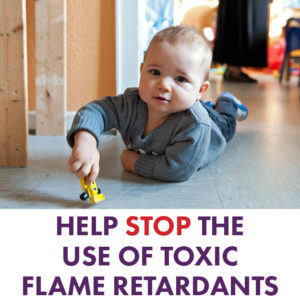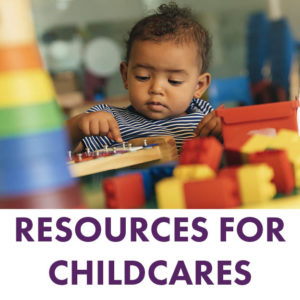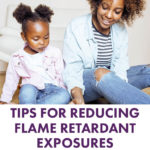Childcare providers want to create a healthy space for children to learn, play, and sleep. But childcares that use foam nap mats can have higher levels of toxic flame retardants in their dust. We wondered whether it was possible to reduce kids’ exposures to toxic flame retardants in childcares. Our new study answers this question with a resounding YES and provides a clear solution for reducing these chemicals not only in childcares, but in schools, homes, and workplaces too.
The Problem
 |
 |
 |
Nap mats used in childcare centers -usually one- or two-inch thick foam mattresses with vinyl covers- can contain toxic flame retardants that can build up in kids’ bodies and cause health problems, including obesity, cancer, and early puberty. The chemicals don’t stay in the foam but move from the foam into the air and dust. Young kids can be exposed when they breathe or ingest the dust.
Could these nap mats be a source of the higher levels of toxic flame retardants in dust?
The Study
We partnered with researchers at Indiana University’s School of Public and Environmental Affairs (SPEA) to test dust and air of Seattle-area childcares before and after switching out nap mats for healthier mats or cots.
What we found was remarkable. By switching to nap mats that don’t contain toxic flame retardants, we could dramatically reduce levels of the chemicals in the centers’ dust by as much as 90%. Complete findings and analysis, including a copy of the peer-reviewed study, are available here.
The Solution is Clear
Flame retardant-laden nap mats are a significant source of flame retardants in childcare centers, but the good news of the study is that it’s possible to do something about it.
Kids shouldn’t be sleeping on, playing in, or breathing in toxic flame retardants. A recent study found that toddlers can have levels of toxic flame retardants up to five times greater than those of their mothers. With research showing the chemicals in the foam of items like nap mats provide no fire-safety benefit, there is no need for these chemicals in consumer products like nap mats.
It’s time to stop the use of toxic flame retardants in nap mats and other products.
Childcare providers do their best to provide a healthy environment for kids. But their hands are tied when toxics like hazardous flame retardants are legally added to products. Even if providers and parents want to find healthier mats, they will have a hard time finding mats free of both flame retardants and vinyl, a soft plastic that can contain hormone-disrupting phthalates. We found one company, Community Playthings, that made a flame-retardant and vinyl-free nap mat. But many childcares and parents can’t afford premium nap mats and the burden shouldn’t be on them.
The only way to ensure ALL kids are protected regardless of their childcare’s or parent’s ability to afford mats without flame retardants is for manufacturers to stop putting flame retardants in mats and for policymakers to ban the use of the chemicals.
Fortunately, there are opportunities to make this a reality.
You Can Help
Late last year, the US Consumer Products Safety Commission (CPSC) voted to move forward with a ban on a particularly harmful class of flame retardants called “organohalogens”. Now they must implement the ban. Add your name to a petition asking the CPSC to take action here.
State policymakers also have a role. Bans in states like Washington, California, and Maine on PBDE flame retardants helped bring on a national phaseout. By passing bans on the next generation of flame retardants, states can create the momentum necessary to finalize a national ban. Washington state is considering recommendations to address additional flame retardants in consumer products. Tell them to make strong recommendations here.
Makers of nap mats must ensure that only the safest materials are used in their products. Flame retardants, vinyl and other chemicals and materials that can harm kids’ health should not be in products. Retailers should stock products that don’t contain these chemicals. The Mind the Store Campaign is working to make sure retailers are selling healthier products. Check out how you can help.
Finally, state and local governments must help childcare centers switch to flame-retardant free nap mats by providing financial assistance to buy new mats, especially to childcares that cannot afford replacements.
Childcare providers are focused on caring for kids and helping them get the best start in life. They shouldn’t have to worry about whether childcare necessities contain harmful chemicals.
Our new study provides ample evidence for makers of nap mats and policymakers that action on nap mats is necessary and that a solution is possible: stop flame retardants at the source and remove them from nap mats and other products.
Now we need manufacturers and policymakers to act so we all can rest easy.




